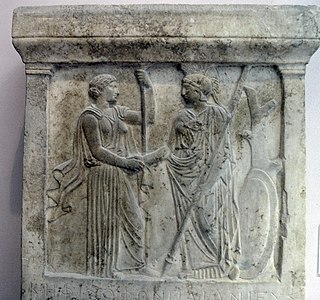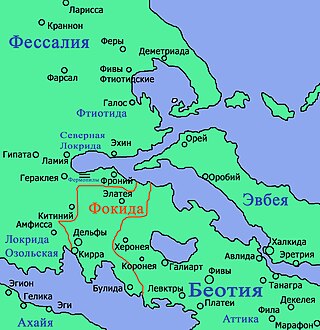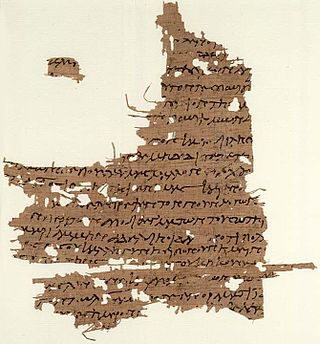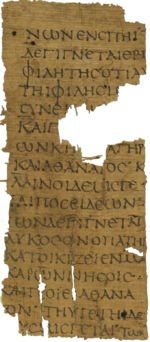
Alcaeus of Mytilene was a lyric poet from the Greek island of Lesbos who is credited with inventing the Alcaic stanza. He was included in the canonical list of nine lyric poets by the scholars of Hellenistic Alexandria. He was a contemporary of Sappho, with whom he may have exchanged poems. He was born into the aristocratic governing class of Mytilene, the main city of Lesbos, where he was involved in political disputes and feuds.
Anaximenes of Lampsacus was a Greek rhetorician and historian. He was one of the teachers of Alexander the Great and accompanied him on his campaigns.
Philochorus of Athens, was a Greek historian and Atthidographer of the third century BC, and a member of a priestly family. He was a seer and interpreter of signs, and a man of considerable influence.

Mytilene is the capital of the Greek island of Lesbos, and its port. It is also the capital and administrative center of the North Aegean Region, and hosts the headquarters of the University of the Aegean. It was founded in the 11th century BC.
Gaius Asinius Quadratus was a Greek historian of Rome and Parthia of the third century. He was a senator who wrote a 15-book history of Rome, Chilieteris, which, according to the Suda, covered the period from the founding of Rome until the rule of Alexander Severus. He also wrote a Parthika in nine books, presumably a narrative of the Parthian campaigns of the preceding century. Some scholars attribute to him a Germanika, based on an excerpt preserved by Agathias, although this is debated.
Acusilaus, Acusilas, Acousileos, or Akousilaos of Argos, son of Cabas or Scabras, was a Greek logographer and mythographer who lived in the latter half of the 6th century BC but whose work survives only in fragments and summaries of individual points. He is one of the authors whose fragments were collected in Felix Jacoby's Die Fragmente der griechischen Historiker.
The logographers were the Greek historiographers and chroniclers before Herodotus, "the father of history". Herodotus himself called his predecessors λογοποιοί.

Lesbos or Lesvos is a Greek island located in the northeastern Aegean Sea. It has an area of 1,633 km2 (631 sq mi), with approximately 400 kilometres of coastline, making it the third largest island in Greece and the eighth largest in the Mediterranean. It is separated from Asia Minor by the narrow Mytilini Strait. On the southeastern coast is the island's capital and largest city, Mytilene (Μυτιλήνη), whose name is also used for the island as a whole. Lesbos is a separate regional unit with the seat in Mytilene, which is also the capital of the larger North Aegean region. The region includes the islands of Lesbos, Chios, Ikaria, Lemnos, and Samos. The total population of the island was 83,755 in 2021. A third of Lesbians live in the capital, while the remainder are concentrated in small towns and villages. The largest are Plomari, Agia Paraskevi, the Gera Villages, Agiassos, Eresos, and Molyvos.
Antiochus of Syracuse was a Greek historian of Magna Graecia, who flourished around 420 BC. Little is known of Antiochus' life, but his works, of which only fragments remain, enjoyed a high reputation because of their accuracy. He wrote a History of Sicily from the earliest times to 424 BC, which was used by Thucydides, and the Colonizing of Italy, frequently referred to by Strabo and Dionysius of Halicarnassus. He is one of the authors whose fragments were collected in Felix Jacoby's Fragmente der griechischen Historiker.

Duris of Samos was a Greek historian and was at some period tyrant of Samos. Duris was the author of a narrative history of events in Greece and especially Macedonia from 371 BC to 281 BC, which has been lost. Other works included a life of Agathocles of Syracuse and a number of treatises on literary and artistic subjects.

The Second Sacred War was the Spartan defeat of the Phocians at Delphi and the restoration of Delphian self-government.

The Oxyrhynchus Papyri are a group of manuscripts discovered during the late nineteenth and early twentieth centuries by papyrologists Bernard Pyne Grenfell and Arthur Surridge Hunt at an ancient rubbish dump near Oxyrhynchus in Egypt.
Pherecydes of Athens was a Greek mythographer who wrote an ancient work in ten books, now lost, variously titled "Historiai" (Ἱστορίαι) or "Genealogicai" (Γενελογίαι). He is one of the authors whose fragments were collected in Felix Jacoby's Die Fragmente der griechischen Historiker.
Hermippus of Smyrna was a Greek grammarian and peripatetic philosopher, surnamed by the ancient writers the Callimachian, from which it may be inferred that he was a disciple of Callimachus about the middle of the 3rd century BC, while the fact of his having written about the life of Chrysippus proves that he lived to about the end of the century. His writings seem to have been of very great importance and value. They are repeatedly referred to by the ancient writers, under many titles, of which, however, most, if not all, seem to have been chapters of his great biographical work, which is often quoted under the title of Lives (Bioi). The work contained the biographies of a great many ancient figures, including orators, poets, historians, and philosophers. It contained the earliest known biography of Aristotle, as well as philosophers such as Pythagoras, Empedocles, Heraclitus, Democritus, Zeno, Socrates, Plato, Antisthenes, Diogenes, Stilpo, Epicurus, Theophrastus, Heraclides, Demetrius Phalereus, and Chrysippus. The work has been lost, but many later Lives extensively quote it.

Papyrus Oxyrhynchus L 3525 is a copy of the apocryphal Gospel of Mary in Greek. It is a papyrus manuscript formed in a roll. The manuscript had been assigned palaeographically to the 3rd century. It is one of the three manuscripts and one of the two Greek manuscripts of the Gospel of Mary. It is shorter than Papyrus Rylands 463.

Karl Wilhelm Ludwig Müller was a German philologist and historian, best known for his Didot editions of fragmentary Greek authors.
Papyrus Oxyrhynchus 12 is a fragment of a chronological work in Greek. It was discovered by Grenfell and Hunt in 1897 in Oxyrhynchus. The fragment is dated to the first or second century. It is housed in the Cambridge University Library. The text was published by Grenfell and Hunt in 1898.
The Phoronis is a lost work by the fifth-century Greek historian Hellanicus of Lesbos. It takes its title from the local Tirynthian culture hero Phoroneus. It was an account of Argolic tradition, consisting mostly of genealogies, with short accounts of various events included, from the time of Phoroneus, the "father of mortal men", to the "Return of the Heracleidae".
Papyrus Oxyrhynchus 1800 is part of a papyrus roll containing biographies of various mythical and historical figures from ancient Greece. The papyrus was discovered in 1905–06 as part of a large group of literary papyri. 31 fragments from the roll were published in the editio princeps; four further published fragments have since been identified as part of the same work. It is dated by the handwriting to the late second century AD. There are a few corrections, possibly in the same hand as the original text. A coronis is used to divide sections.
Damastes of Sigeum was a Greek geographer and historian in the 5th century BC from Sigeum.








